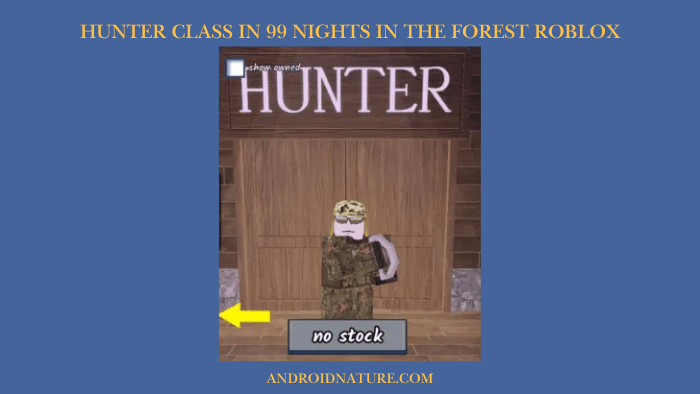The Hunter Class in 99 Nights in the Forest is made for players who prefer staying on the offensive, setting traps, gathering meat, and farming pelts.
It’s not the strongest class in terms of combat, but it offers one of the most practical early-game advantages for survival and trade.
Whether you’re hunting alone or supporting your team with resources, the Hunter brings consistency and reliability.
Hunter Class in 99 Nights in the Forest :Overview
The Hunter can be unlocked for 40 Gems, making it one of the more affordable utility-based classes in the game.
You start with two Bear Traps, which can immobilize cultists or animals long enough to deal the finishing blow.
Beyond its starting tools, the Hunter’s perks focus on increasing meat and pelt drop rates, with an extra wolf pelt trade available at max level.
It’s not flashy or aggressive, but it helps you stock up on food and valuable items faster than most classes.
Hunter Perks
| Level | Perk | Effect |
|---|---|---|
| Level 1 | Increased Meat Drop Rate | Gain more meat from animals — ideal for long survival sessions. |
| Level 2 | Slightly Higher Pelt Drop Rate | Boosts pelt collection, helping you trade faster with the Pelt Trader. |
| Level 3 | Extra Wolf Pelt Trade | Unlocks an additional wolf pelt trade at the Pelt Trader, granting access to valuable items like the Good Sack or Good Axe. |
While other classes rely on abilities or combat power, the Hunter is all about steady income and resource farming. It’s the perfect pick for anyone who enjoys self-sufficiency in the forest.
How to Play the Hunter Effectively
The Hunter isn’t a damage powerhouse, but it excels in resource efficiency and timing.
Here’s how to make the most of it:
-
Set Up Traps Strategically: Bear Traps are your best friend early on. Place them near choke points, camp edges, or cultist spawn routes to secure easy kills.
-
Farm Wolves and Bunnies: Wolves drop valuable pelts, and bunnies are perfect for quick farming sessions. For faster progression, hunt during daytime and continue farming at night by sniping from tree branches or safe ledges.
-
Pelt Trader Synergy: Once you unlock Level 3, the extra wolf pelt trade makes it easy to earn strong gear like the Good Sack, Good Axe, and Good Spear without heavy grinding.
-
Pair with the Big Game Hunter: If your team includes a Big Game Hunter, your combined pelt bonuses will help gather materials much faster for everyone.
-
Watch Out for Trap Glitches: Sometimes Bear Traps may bug out or fail to trigger properly — always carry a ranged weapon as backup.
Pros of the Hunter
-
Cheap unlock cost (40 Gems)
-
Reliable for food and pelt farming
-
Great synergy with trading systems
-
Good early-game utility for both solo and team players
Cons of the Hunter
-
Bear Traps can occasionally glitch or fail to trigger
-
Loses utility after day 99 as resources become abundant
-
Not an offensive class; struggles in direct combat
-
Level 3 progress requires a heavy grind (lots of wolf kills)
Should You Choose the Hunter Class?
If you like the idea of playing methodically, setting traps, farming animals, and trading, the Hunter will suit you perfectly. It’s not built for chaos or heavy fights, but it quietly powers your progression with consistent resources.
Solo players will find it especially rewarding in the early and mid-game, while team players can use it to supply food and pelts during tougher nights.
Trivia
-
The Hunter was first introduced in the Cultist Stronghold Update.
-
It’s one of the few early-game classes that synergize with higher-tier ones like Big Game Hunter and Farmer.
-
Its Bear Trap tool was initially bugged to trap friendly players (later fixed in patch v1.3).
So, that’s all for now folks for the Hunter Class in 99 Nights in the Forest.

Ankit is an engineer by profession and blogger by passion. He is passionate to do all the stuff such as designing the website, doing the SEO, researching for the content, writing tech blog posts and more.










